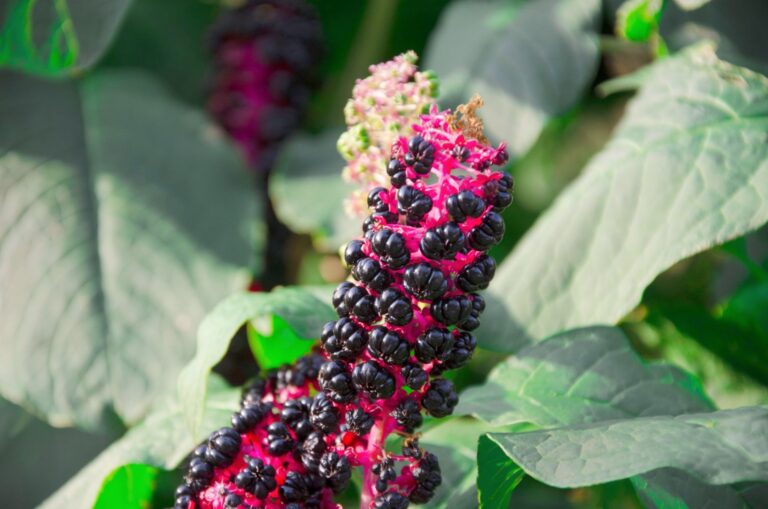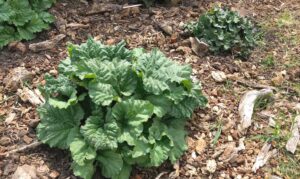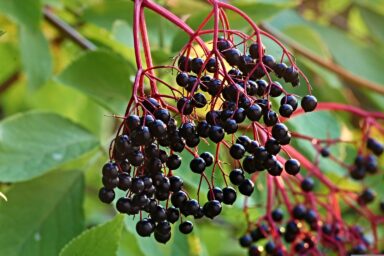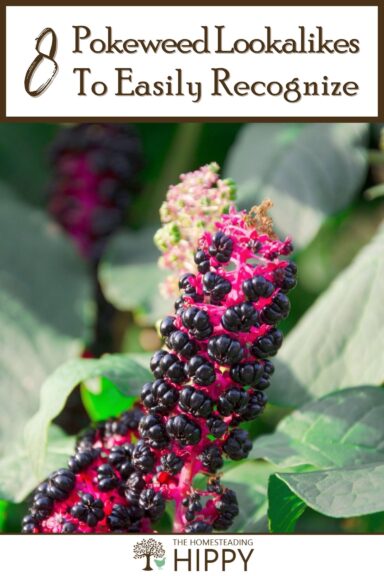Pokeweed, Phytolacca americana, is known for growing very tall, upwards of 10 feet, and appearing where it is least expected or wanted. It’s also known for growing equally large, dense clusters of small, jet black berries.

Although it was a historically important food source throughout much of Appalachia, today it’s predominantly infamous for its tendency to severely poison people and livestock thanks to those attractive but deadly berries.
And to make matters worse, pokeweed has several imitators which might prove to be helpful or harmful at turns.
If you can’t tell the difference between pokeweed and these imposters, you might destroy helpful plants or unknowingly blunder into others that are just as dangerous or even worse!
Keep reading and I’ll tell you about these pokeweed lookalikes and how to recognize them…

Table of Contents
1. Rhubarb (Rheum x hybridum)
Imagine you’re on your property and you spot a plant that might be pokeweed; red, thick stem and all.
What you might have stumbled upon instead is rhubarb, a plant that’s commonly mistaken for pokeweed due to its large green leaves and bright red stalks.
Rhubarb is a perennial, growing back year after year, and a cool-season plant that thrives best in early spring or late autumn.
Unlike pokeweed, which grows berries, rhubarb is known and harvested for its thick, celery-like red stalks.
These stalks are edible and commonly used in pies and preserves, but do be careful: the leaves of the rhubarb plant are toxic if ingested due to high oxalic acid content.
But most interestingly, rhubarb is a uniquely hardy plant that can grow for over a decade, and all the while it does not suffer much from pests.
2. Giant Hogweed (Heracleum mantegazzianum)
Pokeweed is dangerous enough, but there’s always a bigger fish in the sea- or rather, a bigger shrub on the lawn!
If you ever come across a truly towering plant that bears some resemblance to pokeweed, keep a safe distance: it’s likely no pokeweed, but instead the giant hogweed.
This plant is native to the Caucasus Region and Central Asia but has spread across much Europe (especially the UK where it’s a downright menace) and increasingly across North America.
Like pokeweed, giant hogweed has large leaves and a very thick stalk, but it can reach up beyond 14 feet in height, far surpassing the size of any pokeweed.
The giant hogweed plant blooms white flower clusters that can reach an equally impressive 2 ½ feet across.
But admire those flowers from a safe distance: Its sap contains toxic compounds called furanocoumarins, compounds that, if they get on your exposed skin, will react directly with sunlight to cause hideous burns!
Removal is highly perilous for this reason…
A fascinating and grimly depressing fact about giant hogweed is that it was originally brought to England as an ornamental plant in the 19th century, if you can believe it, due to its impressive size and striking appearance when in bloom. Safety be damned, huh?
Sadly, this dangerous novelty quickly spread out of control across the land (and I’m convinced it was sent to America in revenge of our declaring independence from our cousins) to become a significant problem.
Today it is known for its damaging effects on native plants and human health alike, and must be respected wherever it is found.
3. Giant Ragweed (Ambrosia trifida)
The giant ragweed is a dreadfully allergenic lookalike to pokeweed.
Native to North America, this plant is widespread and known for its truly towering height; it can grow between 3 and 12 feet tall, maxing out quite a bit taller than your typical pokeweed.
One of the most distinctive features of this plant is its leaves: they are rough, oppositely growing with 3 to 5 deep lobes and are easily confused with pokeweed leaves.
But unlike pokeweed, the stems of giant ragweed are covered with an even coat of white hairs.
And while it’s not truly harmful, this plant is definitely not “safe” for those with allergies! Giant ragweed is a significant source of seasonal hay fever and can cause intense late-summer misery for any allergy sufferers.
So, if you have allergies, steer well clear of this plant and eliminate if form your surroundings if you can.
4. Knotweeds (Fallopia spp.)
A family of invasive plants, most bearing a striking resemblance to pokeweed. Upon closer inspection, though, you’ll realize they aren’t pokeweed thanks to their unique morphological differences.
Knotweeds are native to Eastern Asia but have become terribly invasive in many other parts of the world, including North America.
Pervasive, persistent, and legendarily tough to eradicate, they are the bane of many gardens and urban areas.
Knotweeds can also grow up to 10 feet tall, comparable to the size of large pokeweed.
Most have large, heart-shaped leaves but their stems are hollow and bamboo-like, which could be mistaken for girthy pokeweed stems.
While not genuinely dangerous, knotweeds are one of the most invasive plants on Earth.
Their roots can grow up to 10 feet deep and burrow steadily and unstoppably, and can cause significant damage to concrete, foundations, and flood defenses.
In the East, despite their destructive nature, knotweeds have been long been used for ceremonial and decorative purposes, though this is no consolation at all for people who must today struggle to eliminate this aggravating invader.

5. Elderberry (Sambucus nigra)
A nominally safe berry, the Elderberry bush is part of the Adoxaceae family, and is native to North America, Venezuela, and Brazil.
Elderberry plants are deciduous shrubs or small trees that stand tall between 5 to 10 feet and spread out anywhere from 6 to 10 feet wide.
What makes them look like pokeweed is their large groups of clustered white flowers that bloom from June to July, followed by large, slightly oblong dark purple berry clusters in late summer.
However, unlike pokeweed, elderberry plants are known for their multitude of culinary uses- so long as they are properly prepared and cooked!
These berries have been used in many recipes for centuries due to their unique, tart taste, and they make wonderful pie filling, jams and syrups.
But do remember: raw elderberries, leaves, bark, and roots of the plant are poisonous and can cause stomach problems if ingested. So, if you’re planning to use them, they must be cooked first to be safe.
6. Japanese Knotweed (Reynoutria japonica)
I know, we already covered knotweed but Japanese Knotweed is distinct, botanically. Native to Eastern Asia, obviously, this plant has become highly invasive in other parts of the world, including North America.
They large, heart-shaped leaves and hollow, bamboo-like stems can again easily be mistaken for pokeweed.
Unlike the toxic pokeweed, this plant contains resveratrol, a compound which scientists are investigating for its (allegedly) anti-aging properties.
However, due to its highly invasive nature, it’s best to leave this plant alone and not let it get a foothold on your property.
The danger of Japanese Knotweed lies not in toxicity but in its sheer invasiveness.
Its roots can grow deep and again cause significant damage to foundations and other constructions, and it’s bafflingly difficult to eliminate: an entire plant can regrow from even a single, tiny chunk of the rhizome!
And since the plant usually has to be extricated by chopping it free or ripping it out with heavy equipment this is sadly likely to occur!
So, if you spot this plant, even if it is small, it’s best to take immediate action to exterminate it before it gets way out of hand.
7. Castor Bean (Ricinus communis)
Native to Eastern Africa, the Mediterranean region, and India, Castor Bean (Ricinus communis) is an evergreen that can grow alternately as a shrub or tree, and in the latter form clears 35 feet, significantly towering over even the largest pokeweed.
The woody stems are adorned with glossy foliage that is deep green to burgundy in color, and these glossy leaves might be mistaken for those of pokeweed.
However, unlike pokeweed, the castor bean plant produces spiky seed pods containing shiny beans.
And be warned: the castor bean plant is extremely toxic to humans. Its seeds contain ricin, a deadly poisonous compound that can be fatal if ingested or even inhaled!
It is also notable for benign incredibly allergenic, and is basically Hell on Earth for asthmatics and allergy sufferers. The sap even causes skin blistering! Good grief.
Happily, the plant has some practical uses. The seeds are used to produce castor oil, which has various other uses itself.
And despite the overt danger of ricin and the plant generally, castor bean is sometimes grown as an ornamental plant due to its striking appearance and rapid growth.
8. Ornamental Jewelweed (Impatiens grandulifera)
Another plant that’s easily mixed up with Pokeweed thanks to the similarity of its flowers, Ornamental Jewelweed is native to the Himalayas, but has been introduced to other parts of the world where it thrives as a pretty but destructive invasive species.
Ornamental jewelweed is a tall, annual that can grow up to 6 feet high, similar to average Pokeweed.
The large, serrated leaves and beautiful pink flowers that droop from the stems may likewise make it easily confused with pokeweed.
However, unlike Pokeweed, Ornamental Jewelweed is safe to touch and is not known to be toxic or dangerous, and is often cultivated for its nectar and petals which are edible.
Another incredible fact is that its seeds literally pop out of the pods when they’re touched, hence the common nickname ‘touch-me-not’.
Although startling, this harmless reproductive strategy helps the plant scatter seeds many feet from itself in all directions. Suffice to say, Pokeweed, mercifully, doesn’t pop when touched!

Tim is a farm boy with vast experience on homesteads, and with survival and prepping. He lives a self-reliant lifestyle along with his aging mother in a quiet and very conservative little town in Ohio. He teaches folks about security, prepping and self-sufficiency not just through his witty writing, but also in person.
Find out more about Tim and the rest of the crew here.
